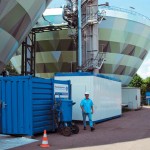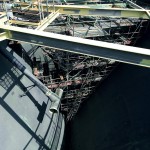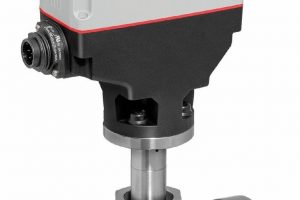Some 7000 m² of steel had to be examined in the biological wastewater treatment plant at Griesheim Industrial Park in Frankfurt and, depending on the extent of the damage, newly coated and refurbished. A five-strong team of corrosion protection experts from ThyssenKrupp Xervon was involved with this task from April to September 2009. It was the third successful reactor refurbishment job carried out for this customer.
At Griesheim Industrial Park, two bioreactors are responsible for the biological cleaning of wastewater from chemical equipment before it is discharged into the River Main. The tanks, in which microorganisms aerobically convert carbon compounds into CO2, H2O, energy, nitrates and phosphates, are each 20 m tall and have a volume of 18,000 m³. Put simply, microorganisms break down the organic substances in the wastewater with the addition of air.
As these are steel tanks, the time eventually comes when the reactors have to be checked for damage inside and outside and their anti-corrosive coating has to be renewed. At Griesheim Industrial Park that was the case in 2009. From April to September, corrosion protection experts from Thyssen-Krupp Xervon refurbished one of the two reactors. The five-strong team examined some 7000 m² of steel plate in this short period and, depending on the extent of the damage, removed localised or larger areas of rust by high-pressure water jetting before applying a new coating. The schedule for the work was tight, so the fact that the scaffolding services were also provided by ThyssenKrupp Xervon was a great advantage. The two teams coordinated their work closely and thus saved time.
In a first step, the scaffold erectors installed a movable, suspended scaffold from which work was carried out on the exterior of the bioreactor. The team of ten scaffold erectors was also responsible for roughly 7900 m³ of technically demanding scaffolding for the funnel-shaped interior of the reactor as well as the scaffolding for the scrapers, which remove sludge from the steel tank during operation. A particular challenge here was that despite the scaffolding it still had to be possible to move the scrapers to give the corrosion protection specialists access to all areas, no matter how small. In addition, the erectors also had to construct various small scaffolds more or less on demand for all of the specialists involved in the refurbishment project, which alongside the corrosion protectors included pipe fitters and steel construction workers.
Two anti-corrosive systems
Two different anti-corrosive coating systems were used to coat the inside and the outside of the bioreactor, both specially tested for wastewater compatibility. The key selection criterion was the coating’s ability to withstand varying pH values and resist aggressive wastewater. However, as each application involves its own specific conditions, coating systems are usually selected by agreement between the customer, the coating manufacturer and the anti- corrosion specialists. Load scenarios are played out in intensive advance discussions and systems chosen together with the manufacturer of the coating material.
Due to their angular design, the scrapers inside the reactor and the exterior support structures were given a roughly 400 µm thick three-layer coating. As these parts have smaller surfaces as well as numerous corners and edges, applying a three-coat system ensured that all areas received a multiple coating. An epoxy resin-based, two-component material reinforced with iron mica was used. Anti-corrosion coatings containing iron mica are extremely weather-resistant. The iron mica platelets create a barrier effect by extending the diffusion time. Iron mica also displays low boundary adhesion with most organic binder systems, allowing aging-related stresses to be reduced. The material was mainly applied by brush and roller, and in some areas also by airless spraying. To achieve better coating adhesion, all surfaces were blast-cleaned to Sa 2.5 finish. To ensure a good bond between the old and new coatings in areas of partial application, the edge areas were blasted carefully to provide a clean surface and the minimum required roughness.
All other damaged areas – large surfaces free of other components – were protected with a hot, solvent-free coating. This was also an epoxy-based, two-component system mainly used for lining tanks. The coating is physiologically safe, very easy to clean and anti-static. The two components of this system (parent component and curing agent) are solvent-free and highly viscous when cold. When heated, they become flowable and can be processed. For this reason, the coating material is heated to approx. 70 to 80 °C and sprayed airlessly onto the surfaces to be treated. A special feature of the hot coating is that it comprises only one layer. In this particular job, the coating was applied with a thickness of between 600 and 1000 µm. In principle, this system can be employed for coatings up to 2500 µm thick. Due to its suitability for a broad range of applications, the corrosion protection experts from ThyssenKrupp Xervon frequently use it to coat tanks in the petrochemical industry. It is applied by a special coating machine with a static mixer, a two-piston pump, a hose package, an airless spray nozzle and a heating unit for the coating.
Online-Info www.cpp-net.com/2310450
Share:









